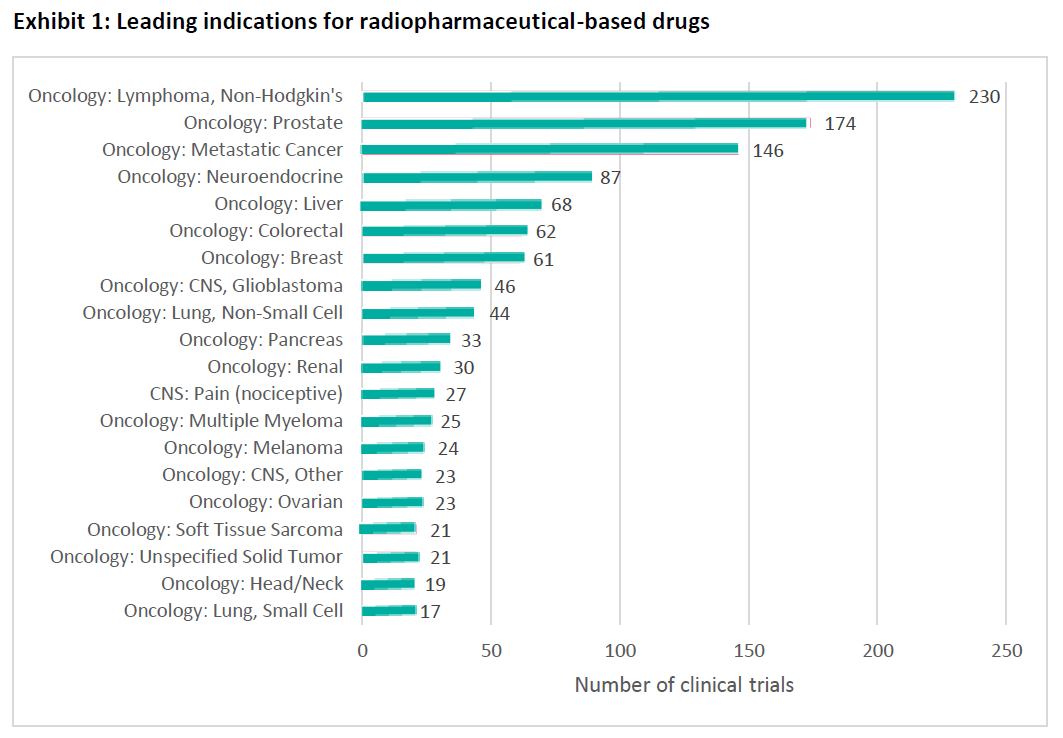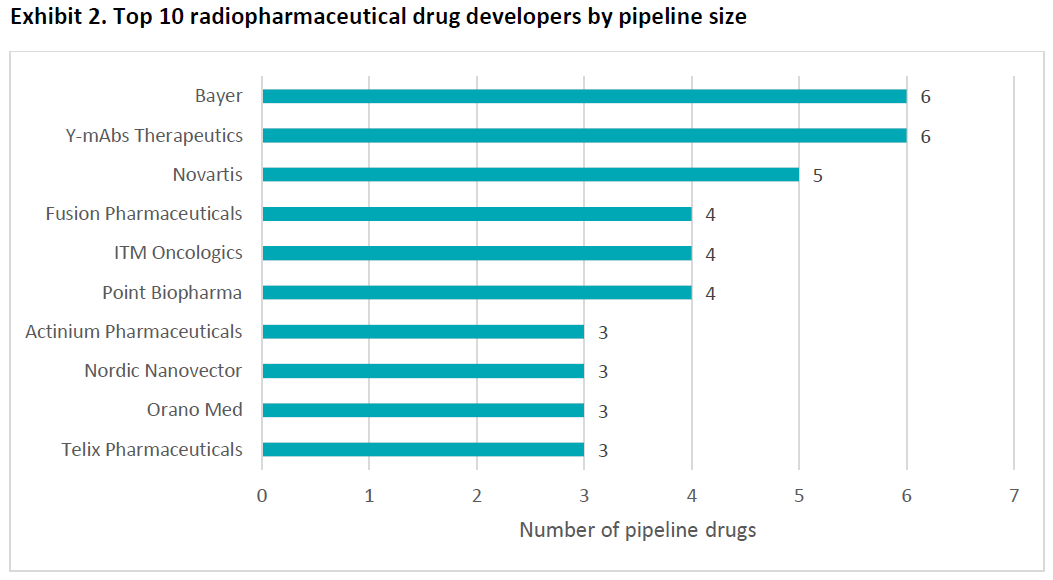Radiopharmaceuticals: A New Approach to Cancer Treatment
Article
Clinical


Although radiation has been used for more than a century to treat cancer, radiopharmaceuticals are relatively new. They are defined by the delivery of radioactive atoms directly and specifically to tumor-associated targets on cancer cells. In contrast to radiotherapy, the radiation is not administered from outside the body, but is delivered systemically or locoregionally as a chemotherapy or biologically targeted therapy.
Radiopharmaceutical therapy is an emerging targeted approach to treat cancer, whose potential with specific tumor-associated targets is now being recognized.
By Renu Bala, Senior Analyst, Trialtrove
Radiopharmaceuticals, also known as medicinal radio compounds, are a group of drugs containing radioactive isotopes that can be used as diagnostic and therapeutic agents. Although radiation has been used for more than a century to treat cancer, radiopharmaceuticals are relatively new. Radiopharmaceutical therapy is defined by the delivery of radioactive atoms directly and specifically to tumor-associated targets on cancer cells. In contrast to radiotherapy, the radiation is not administered from outside the body, but is delivered systemically or locoregionally as a chemotherapy or biologically targeted therapy.
The cytotoxic radiotherapy is delivered to cancer cells either directly or using delivery vehicles that either bind specifically to endogenous targets or accumulate by several physiological mechanisms characteristic of neoplasia, adopting a targeted therapeutic approach. It is not necessary for radiopharmaceuticals to get inside cells to work best. Once a radiopharmaceutical has stuck to a cancer cell, the radioactive compound naturally breaks down and releases energy that damages the DNA of nearby cells. When a cell’s DNA is irreparably damaged, it dies. Cancer cells are specifically sensitive to radiation-induced DNA damage.
Radiopharmaceuticals are part of an approach called theragnostic that uses one radioactive drug component to identify (diagnose) and another separate component to deliver the therapy. The radioactive and targeting molecules are joined by a linker, and the overall treatment can be delivered orally, intravenously, or interstitially.
Radiotherapy provides several advantages over existing therapeutic approaches. Targeting radiation at the cellular level has the potential to reduce the risk of side effects of treatment and enable even minute deposits of cancer cells to be killed throughout the body. In comparison to other systemic anticancer therapies, radiopharmaceutical therapy has shown efficacy with minimal toxicity. Common side effects such as alopecia or peripheral neuropathy are generally less severe than seen with chemotherapy. Responses with radiopharmaceutical agents typically do not require prolonged treatment durations and are often observed after a single or at most five injections. From a drug discovery viewpoint, radiopharmaceuticals are far less dependent on an understanding of signaling pathways and on identifying agents interrupting the recognized cancer phenotype-driving pathways.
Clinical experience with radiopharmaceuticals is growing rapidly. As of February 2022, Trialtrove identifies 1,091 trials that involve a radiopharmaceutical-based treatment, spread across approximately 3,400 different clinical sites. More radiopharmaceutical trials initiated in 2021 (80) than in any prior year, a trend that has been consistent since the beginning of the last decade.
The vast majority of clinical development for radiopharmaceuticals is for the treatment of cancer. The top 11 most studied indications ― and 19 in the top 20 ― are in oncology, with non-Hodgkin’s lymphoma the most studied disease, ahead of prostate cancer. The top 20 diseases for clinical development are shown in Exhibit 1.

Source: Trialtrove, February 2022
Among this number, there are currently 22 ongoing or planned industry-sponsored Phase III trials. These are the studies that guide clinical practice for radiopharmaceuticals, and they are spread among a range of different sponsors. Novartis leads the way with four ongoing Phase III trials, ahead of Bayer and Cellectar Biosciences (three each).
Novartis’s studies include three trials investigating Lu-PSMA-617 as a promising therapeutic strategy for metastatic castration-resistant prostate cancer patients. Data produced so far indicate that drug treatment leads to a 38% reduction in risk of death when added to standard of care, with a median overall survival benefit of four months. When factoring disease progression as well as death, the risk reduction improves to 60% with a median progression-free survival of five months. Lu-PSMA-617 is currently undergoing regulatory review, with approvals in the US and EU expected in the first half of 2022. Novartis’s other late-stage trial is for Lu-oxodotreotide, approved in 2018 for the treatment of neuroendocrine tumors and is marketed as Lutathera.
The company’s leadership position in radiopharmaceuticals comes after considerable investment. Novartis gained access to Lutathera through its acquisition of Advanced Accelerator Applications in a deal worth $3.9 billion in 2017, while a later deal with Endocyte in 2018 for $2.1 billion brought Lu-PSMA-617 to Novartis’s pipeline.
Bayer is another leading sponsor of radiopharmaceutical research in oncology through its development of radium-223 dichloride, which is approved and marketed as Xofigo. The drug became the first approved radiopharmaceutical for prostate cancer in 2013 when it was licensed for patients with bone metastases. Ongoing clinical research is evaluating its use for prostate cancer in combination with other agents, including docetaxel, enzalutamide, and darolutamide.
According to the global R&D database Pharmaprojects, there are currently 27 different radiopharmaceuticals approved for use in oncology. Excluding those that are used as imaging agents, this leaves 12 strictly therapeutic agents that employ targeted radiation to treat cancer. Half of these are approved for the treatment of prostate cancer, while the remainder are used across a wide range of other solid tumors.
The pipeline is much larger, containing 61 investigational radiopharmaceutical therapies and a further 83 imaging agents. Bayer and Y-mAbs have the largest radiopharmaceutical pipelines with six drugs each in development for at least one cancer indication, slightly ahead of Novartis. These are shown in Exhibit 2.

Source: Pharmaprojects, February 2022
Y-mAbs’s pipeline includes omburtamab, a monoclonal antibody that targets B7-H3 and can be linkedto a number of different radioactive components. Variants include iodine-131, iodine-124, andlutetium-177, each of which are being studied across a range of central nervous system cancer types.Omburtamab is currently under regulatory review in Europe, and Y-mAbs is seeking a regulatory pathforward in the US after an initial refusal to file letter.